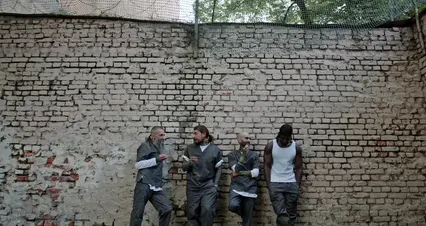
Why Did Alcatraz Close?
Introduction
Alcatraz, known for its notorious reputation, was a federal prison. It operated from 1934 until its closure on March 21, 1963. This closure marked a significant shift in the American prison system. Curious about why this infamous institution shut its doors? Let’s explore the reasons and their lasting impact.
Understanding the reasons behind Alcatraz’s closure provides insight into the evolution of the American penal system. Why was Alcatraz closed?
Summary and Overview
Alcatraz began its life as a military fort before becoming a federal prison in 1934. It housed some of America’s most dangerous criminals, gaining fame for its harsh conditions and high-security measures. During its peak in the 1950s, Alcatraz could hold up to 450 inmates, but regularly housed only around 250. Its reputation for being escape-proof added to its mystique. However, the prison faced several challenges leading to its closure, including mounting operational costs and shifting policies in criminal justice. Today, Alcatraz stands as a historic site, attracting tourists eager to learn about its storied past.

Planning a visit to this historic site? Make sure to grab National Park Service Alcatraz Island Tour Tickets for an unforgettable experience. Explore the cells, learn the history, and maybe even hear some ghost stories along the way!
Historical Context of Alcatraz
Evolution of Alcatraz
Alcatraz Island has a rich history, starting as a military fort in the mid-1800s. Initially, it served as a harbor defense, but by 1907, it became a military prison. Transitioning to a federal penitentiary in 1934, it was designed to hold the most dangerous criminals. Key figures like warden James A. Johnston shaped its legacy, enforcing strict rules that inmates had to follow.
The prison housed infamous inmates such as Al Capone and Robert Stroud, who became known as the “Birdman of Alcatraz.” These notorious figures added to the prison’s lore, attracting media attention and public intrigue. Want to dive deeper? Check out The Birdman of Alcatraz (DVD) for a gripping portrayal of his life.

As conditions and policies evolved, the prison faced increasing scrutiny. The high operational costs and the aging infrastructure contributed to its eventual decline. Alcatraz closed its doors in 1963, making way for new approaches in the American penal system. Today, it serves as a reminder of the past, drawing visitors interested in its unique history and enduring legacy.
Reasons for Closure
High Operational Costs
Alcatraz was a financial burden for the federal government. Operating this maximum-security prison came with steep expenses. By the early 1960s, the annual budget for Alcatraz exceeded $3 million. In contrast, other federal prisons operated with significantly lower costs. For example, similar facilities could function on a budget of around $1 million per year. This disparity raised concerns about the viability of keeping Alcatraz open.

The costs included maintaining the aging infrastructure and providing for the security measures necessary to house dangerous inmates. Alcatraz had advanced features like guard towers and reinforced walls. Still, the upkeep was more expensive than other prisons. To make your next camping trip as secure as Alcatraz, consider packing a Camping Lantern to illuminate your nights!
Declining Inmate Population
The inmate population at Alcatraz began to decline in the years leading up to its closure. During the 1950s, it housed around 250 inmates regularly. However, by 1963, that number dropped significantly. Changing federal policies led to a shift in inmate demographics. The government started emphasizing rehabilitation over strict punishment. This change meant fewer high-security inmates were sent to Alcatraz.

Moreover, the need for such a high-security facility diminished. Many inmates were being transferred to lower-security prisons, leading to a reduced population at Alcatraz. By the time it closed, it was clear that the prison was no longer necessary for the federal system. The declining numbers, combined with rising operational costs, made closure inevitable.
Changes in Criminal Justice Policies
In the 1960s, criminal justice policies began to shift significantly. The focus started moving from strict punishment to rehabilitation. This change reflected a growing understanding of the need for reform in the prison system.

Legislation like the Crime Control Act of 1968 aimed to enhance rehabilitation efforts. It emphasized vocational training and educational programs for inmates. Want to explore more about the history of the American penal system? Grab a copy of History of the American Penal System (Book) to dive deeper into the subject!
Deteriorating Infrastructure
As Alcatraz approached its closure, the prison’s physical condition worsened. The buildings required extensive repairs, and the island’s location complicated maintenance. Oceanic exposure led to rust and decay of structures.

Reports indicated that Alcatraz needed around $5 million in repairs. However, the federal budget allocated only a fraction of that amount. This disparity made it clear that sustaining the facility was no longer feasible.
Public Perception and Political Climate
Public opinion regarding prison conditions evolved dramatically during the 1960s. Many began to view harsh conditions as inhumane and counterproductive. Political movements advocating for social justice gained momentum, influencing public sentiment.

Notable figures like Martin Luther King Jr. and various activists highlighted the need for prison reform. Their efforts brought attention to the plight of inmates and the need for compassionate approaches. This shift in perception contributed to Alcatraz’s closure, as society demanded better treatment for individuals within the prison system.
Native American Occupation
From November 20, 1969, to June 11, 1971, Alcatraz was the center of a significant Native American occupation. Activists, including members of the American Indian Movement (AIM), asserted their rights over the island. They protested against the U.S. government’s neglect of Native American issues and demanded better treatment and recognition.

This occupation was more than just a stand for land. It became a pivotal moment in American history, highlighting the struggle for civil rights among Native Americans. The activists turned Alcatraz into a symbol of resistance, drawing national attention to the injustices faced by Indigenous peoples. Want to learn more about the history of Alcatraz? Check out The History of Alcatraz: An Interactive History Adventure (Book)!
Current Status as a Historic Site
After its closure, Alcatraz transformed into a popular tourist destination. The site became part of the Golden Gate National Recreation Area in 1972, preserving its rich history. Today, Alcatraz attracts around 1.5 million visitors each year, eager to explore its infamous past.

Visitors can take guided tours, which often include audio recordings featuring former inmates and guards. These stories bring the prison’s history to life, making the experience even more immersive. The iconic buildings and stunning views of San Francisco Bay further enhance the appeal of this historic site. To make the most of your visit, consider bringing along a Photography Book: San Francisco to capture those stunning views!
FAQs
What was the main reason for Alcatraz’s closure?
Alcatraz closed primarily due to high operational costs. Maintaining the facility was expensive, with an annual budget exceeding $3 million. Additionally, a declining inmate population made its existence less necessary. Shifts in criminal justice policies also played a role, focusing on rehabilitation rather than punishment. Finally, the infrastructure was deteriorating, complicating maintenance and repairs. These factors combined led to the decision to close this notorious institution.
When did Alcatraz officially close?
Alcatraz officially closed on March 21, 1963. This date marked the end of an era for the infamous prison. It had operated for nearly 30 years, housing some of America’s most dangerous criminals. The closure was a significant moment in the history of American corrections, leading to a shift in how prisons were managed and perceived.
How many inmates were housed at Alcatraz?
Alcatraz had a capacity of approximately 450 inmates. However, it typically housed around 250 prisoners at any given time. This lower population was due to changing federal policies and a shift in the types of inmates being incarcerated. The prison was known for its strict rules and high-security measures, which made it a unique environment for those serving time there.
Is Alcatraz open to the public today?
Yes, Alcatraz is open to the public today. After its closure, the island became part of the Golden Gate National Recreation Area in 1972. Visitors can explore its historic buildings and learn about its notorious past. Guided tours offer insights into the lives of inmates and the prison’s operations. It attracts around 1.5 million visitors each year, eager to experience this iconic site.
What were the conditions like in Alcatraz?
Conditions in Alcatraz were notoriously harsh. Inmates lived in cramped cells, often with minimal privacy. The prison enforced strict rules, requiring silence during most hours. Meals were basic, and recreation time was limited. The cold island climate added to the discomfort. Despite these challenges, many inmates formed a sense of camaraderie, navigating life within the confines of the infamous prison.
Were there successful escape attempts from Alcatraz?
Yes, there were several notable escape attempts from Alcatraz. One of the most famous incidents occurred in 1946, known as the “Battle of Alcatraz.” In this violent escape attempt, inmates tried to break free, resulting in the deaths of two guards and three escapees. While some inmates managed to escape, the strong currents of San Francisco Bay posed significant challenges. Many were never found, adding to the prison’s legend.
How has Alcatraz influenced modern prisons?
Alcatraz has had a lasting impact on modern prison practices. Its reputation for being escape-proof led to innovations in security measures. The focus on inmate rehabilitation began to shift, influencing how facilities operate today. Alcatraz’s history also sparked discussions around prison reform, highlighting the need for humane treatment. This shift in perspective continues to shape policies in correctional facilities nationwide.
Please let us know what you think about our content by leaving a comment down below!
Thank you for reading till here 🙂 And don’t forget to pack your Travel Backpack for your upcoming adventures!
All images from Pexels




